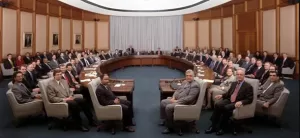Bill Dores
“Probably every slave imported represented, on the average, five corpses in Africa or on the high seas. The American slave trade meant, therefore, the elimination of 60 million Africans.”
—Armet Francis, “The Black Triangle”
“As valuable a family as was ever offered for sale, consisting of a cook about 35 years of age, and her daughter about 14, and son about 8. The whole will be sold together or a part of them, as may suit a purchaser.”
—Ad in The Charleston (South Carolina) Courier, April 12, 1828
The bones of enslaved Africans lie in unmarked graves on both sides of the Atlantic and beneath its gray waters. But the wealth slave labor created is not gone with the wind. It lives on as capital in the huge fortunes of “great” capitalist families — the Rockefellers, Morgans, Mellons, DuPonts and others — who have invested it again and again. It is in the skyscrapers of Manhattan and New England’s Ivy League universities. It is in railroads, airlines, steel mills, auto plants, oilfields, hotels, dotcoms and telecoms. It lies in bank vaults beneath Wall Street and is traded on the New York Stock Exchange.
Those who “own” this wealth have power over those whose ancestors created it — and over working people in every country. When bankers “red line” a Black community or foreclose on homes, they exercise that power. So does a corporation when it shuts a plant in South Carolina or the South Bronx to seek still cheaper labor in Haiti or Mexico. It is on display when plant shutdowns devastate Black and other working-class communities. It is in action when the World Bank forces an African country to “open” its public sector to Western investors in order to eventually privatize it.
Profits from the slave trade “provided one of the main streams of capital accumulation in England that financed the Industrial Revolution,” wrote Eric Williams, the first prime minister of Trinidad and Tobago. Malachi Postlethwayt, an 18th-century slavery apologist, called the British empire a “magnificent superstructure of American commerce and naval power built on an African foundation.” Britain’s North American colonies that rose on that foundation became the United States. Ports like Boston, New York City, Baltimore and Charleston were built on the “triangular trade” that brought enslaved Africans to Caribbean sugar plantations.
The New York Stock exchange now stands on what was once an auction block for slaves.
For much of the 19th century, cotton grown by enslaved Africans made up 60 to 80 percent of U.S. exports. Slave-grown tobacco and rice comprised much of the rest. Slave-grown cotton also fed New England’s textile mills, which gave birth to U.S. industrial production. In 1860 the “market value” of the 4 million human beings enslaved in the US South was $3.5 billion. That’s nearly $4 trillion in today’s money and more than the combined value of all factories and railroads in the United States at the time.
The wealth of many top U.S. corporations can be traced directly to slavery. Fleet-Boston Bank, once Providence Bank, was founded by Rhode Island slave merchant James Brown, who also endowed Brown University. Yale and the University of Virginia are also among the universities endowed by slave merchants and slave owners. Yet, while the racist “war on drugs” has sent millions of Black youth to prison, Black students make up under 6 percent of the Yale student body.
Slave owners who got rich in the cotton trade started Lehman Brothers investment bank. Alex Brown and Sons, which merged with the German giant Deutsche Bank in 1999, financed the cotton trade. DB is the Trump empire’s biggest creditor.
Brown Brothers Harriman made a fortune loaning plantation owners money to buy slaves. When the planters could not meet their debt, Brown seized and worked their assets, including the slaves. A one-time partner was Prescott Walker Bush, whose grandson lived in the slave-built White House, thanks to an electoral-college system created to give slave owners political power. Prescott Bush continued the firm’s tradition by doing business with the Nazis. Prescott Bush was on the board of directors of the Thyssen steel and coal company in Germany, which financed Hitler’s rise to power.
The second-largest banking group in the U.S. is JPMorgan Chase, a merger of the Rockefeller and Morgan banking empires. In 2019 it made over $44 billion in operating profits on assets of $2.687 trillion. Among the banks merged into it are Citizens Bank and Canal Bank of Louisiana, who loaned plantation owners the mopey to buy slaves. Between 1831 and 1865, those banks accepted 13,000 enslaved human beings as “collateral” on loans. In June of this year, a study by Chicago newsrooms City Bureau and WBEZ found JPMorgan Chase to have the most racist lending practices of any bank in that city of 1 million Black people. For every dollar invested in white neighborhoods, it loaned 2.4 cents to Black communities (The Nation, Daniel Fernandez, July 6, 2020.)
Because of slave rebellions and escapes, the slave trade could not survive without insurance. Lloyds of London, the giant shipping broker, made a fortune insuring slave ships. U.S. insurance giants Aetna, New York Life and AIG acquired companies that insured slaves as “property.” Today these same insurance firms are pushing doctors and employers to cut health costs while millions of African Americans are without health insurance.
Before the Civil War, “the backbone of the South’s railway labor force of track repairmen, station helpers, brakemen, firemen and sometimes even engineers” was slaves, wrote University of Pennsylvania historian Walter Licht in “Working on the Railroad.” After emancipation, the rail bosses forced Black workers out of most of these jobs. It wasn’t until the 1960s that Black railroad employment rose again.
Slaves, usually “rented” from their owners, built 94 rail lines in the old South. Today Norfolk Southern, CSX, Union Pacific and Canadian National own these lines. The big railroad companies have eliminated nearly 800,000 jobs over the past four decades, striking hard at Black communities.
The Capitol building was also built by slave labor. A freed Black architect designed much of Washington. George Washington, a very wealthy slave owner, had the city built between the states of Virginia and Maryland to take advantage of slave labor. Today you will find many descendants of slave owners in the millionaires’ club called the U.S. Senate, but only three descendants of slaves. Only 10 African-Americans have served in the US Senate since 1789.
Today U.S. corporations still benefit from the legacy of slavery, lynch law and “Jim Crow.” Witness the lucrative modern slavery of the prison-industrial complex, the lower average wages paid to Black workers and the union organizing drives broken by racist division.
The long fight for reparations
Ever since 1865, when President Andrew Johnson revoked Gen. William Tecumseh Sherman’s Special Field Order 15, which promised freed Black families 40 acres and a mule, the fight for reparations has been part of the Black freedom movement. In the 1890s, after bloody massacres overturned Reconstruction in the South, the Mutual Ex-Slaves Relief Bounty and Pension Association was formed to fight for them. Between 1890 and 1910 at least five bills for reparations were introduced in Congress.
In 2002, Daedra Farmer-Paelman, whose research has uncovered many corporate ties to slavery, launched a class-action suit against Aetna Life insurance, FleetBoston Bank and CSX Railroads on behalf of all the descendants of slaves.
In June, New York State Assembly member Charles Barron introduced Bill A3080A to the Assembly, calling on New York to pay reparations to African-Americans who live in the state.
“When we come together around serious issues like reparations, we are not playing,” said Barron at a July 2 press conference by the African Burial Ground in lower Manhattan. “We don’t play with the blood of our ancestors. Reparations is a debt owed. A crime has been committed. A people have been injured. And compensation is due.” He called for people to contact their state representatives and demand the bill be passed. “Whenever they say they want to make up a task force, ask them who makes up the task force?”
Andre Powell is an executive board member of AFSCME Local 112 who attended the 2001 United Nations World Conference against Racism in Durban, South Africa, where reparations gained worldwide attention. Powell said:
“The fight to be paid for work performed is a basic trade union demand. But it goes beyond that. It exposes the fact that profits are nothing but unpaid labor and that idea terrifies Corporate America.
“Karl Marx said that ‘capital is dead labor that lives anew by the hand of the living.’ Corporate America owes its wealth and power over us to the dead labor of generations of Black people who were literally worked to death. The fight for reparations can turn this whole country around.”
[Sources for this article include Daedra Farmer-Paelman, “Capitalism and Slavery” by Eric Williams and “How Europe Underdeveloped Africa” by Walter Rodney.
Bill Dores is a US socialist activist. Article courtesy: Struggle for Socialism, a US socialist publication.]




